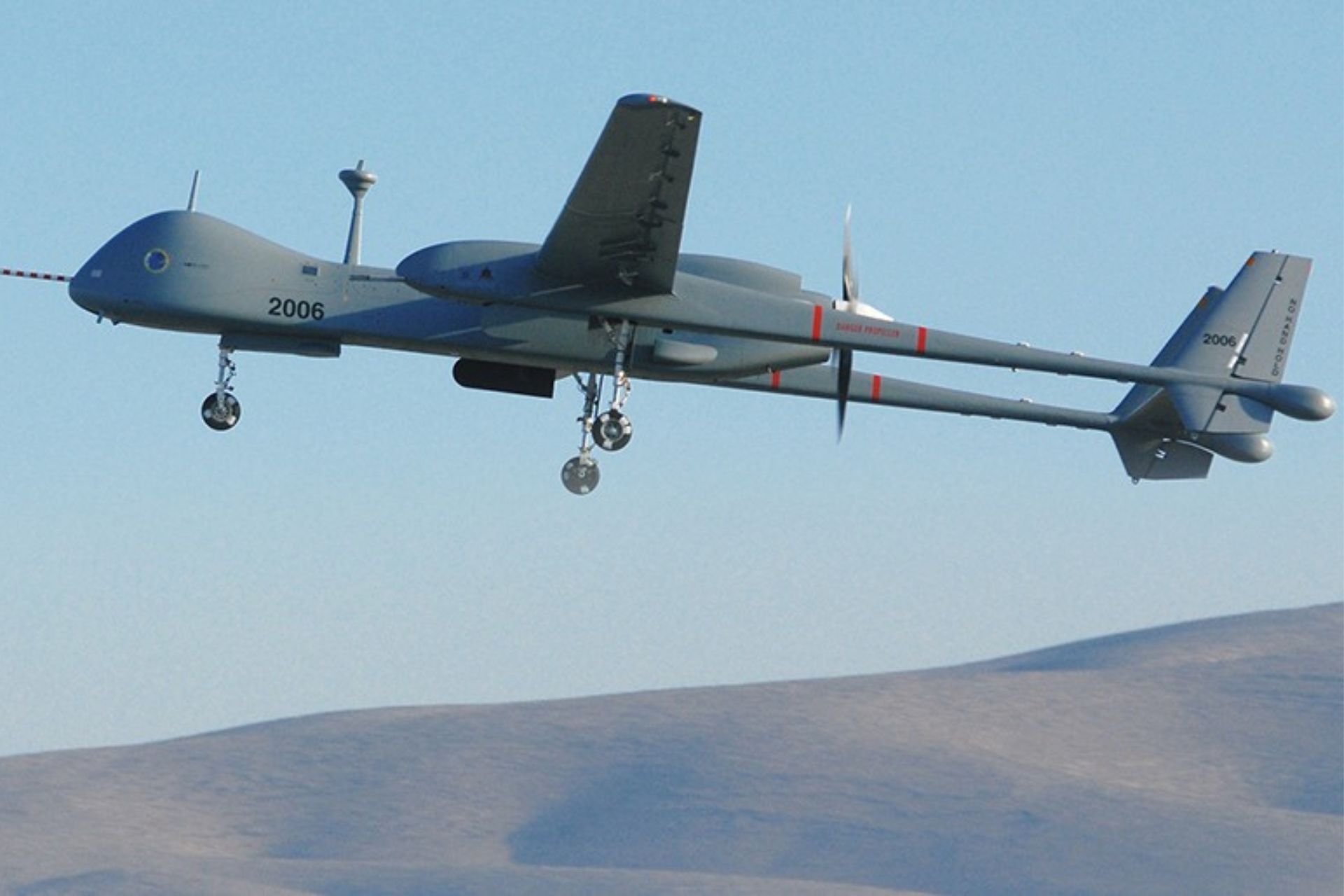Germany Explores its UAV Capabilities with First Flight of Heron TP Drone in Netherlands

{loadposition bannertop}
{loadposition sidebarpub}
The German Heron TP (GHTP) has conducted its first flight in Dutch airspace after receiving authorization from the Dutch Civil Aviation Authority, as reported by Defence Network. This approval was granted as part of the German Air Force’s operational activities with the system, marking its gradual integration into European missions. The flight took place from Jagel Airport in Germany to the Netherlands, representing a key milestone in the use of Medium Altitude Long Endurance (MALE) drones by the German armed forces.
Follow Army Recognition on Google News at this link
With a payload capacity of 2,700 kg, the GHTP can carry a wide range of sensors and military equipment (Picture source: IAI)
The GHTP is an unmanned system designed for surveillance, reconnaissance, and strategic intelligence, based on the Heron TP, developed by Israel Aerospace Industries (IAI). Operated through a partnership between Airbus and IAI, it has an endurance of over 30 hours and can reach an altitude of 45,000 feet, allowing it to operate above commercial air traffic. It meets NATO STANAG 4671 standards, facilitating its integration into multinational operations. The system is equipped with satellite communications (SATCOM) for Beyond Line of Sight (BLOS) control, an automated takeoff and landing system (ATOL), and triple-redundant avionics, ensuring reliability for extended missions.
With a payload capacity of 2,700 kg, the GHTP can carry a wide range of sensors and military equipment. It includes advanced electro-optical and infrared systems, surveillance radars, and electronic warfare technologies (SIGINT and EW). This modular architecture allows for mission adaptability, including aerial surveillance, ground force support, and target designation. Powered by a 1,200-horsepower PT6 turboprop engine, it reaches a maximum speed of 220 KTAS, combining endurance and operational flexibility.
The GHTP originates from the Heron TP, a drone that has been deployed in operations by the Israeli Defense Forces. It represents an evolution of the Heron 1, a system extensively used by Germany for over a decade in Afghanistan and Mali. By selecting the Heron TP, Germany opted for a ready-to-use system aligned with NATO requirements. The GHTP stands out for its reconnaissance and surveillance capabilities while ensuring sovereignty and interoperability within allied forces.
The integration of this drone into the German Air Force is part of a broader strategy to enhance its MALE drone capabilities. At the same time, Germany plays a central role in the Eurodrone project, a joint program with France, Italy, and Spain, aimed at developing a European MALE drone. Initiated in 2016, the project has encountered challenges due to industrial requirements and technical differences among participating countries. Germany, in particular, has emphasized twin-engine propulsion, leading to increased costs and delaying the initial 2025 delivery schedule. These differences illustrate that while European collaborations foster joint technological advancements, they can also slow down operational deployment compared to direct acquisitions from established industrial partners.
The GHTP’s first flight in the Netherlands represents a tangible step for Germany, providing an immediately available system to enhance its strategic autonomy. This integration highlights the growing role of MALE drones in intelligence, surveillance, and reconnaissance missions, while also strengthening European cooperation on military drone operations and airspace regulation.

{loadposition bannertop}
{loadposition sidebarpub}
The German Heron TP (GHTP) has conducted its first flight in Dutch airspace after receiving authorization from the Dutch Civil Aviation Authority, as reported by Defence Network. This approval was granted as part of the German Air Force’s operational activities with the system, marking its gradual integration into European missions. The flight took place from Jagel Airport in Germany to the Netherlands, representing a key milestone in the use of Medium Altitude Long Endurance (MALE) drones by the German armed forces.
With a payload capacity of 2,700 kg, the GHTP can carry a wide range of sensors and military equipment (Picture source: IAI)
The GHTP is an unmanned system designed for surveillance, reconnaissance, and strategic intelligence, based on the Heron TP, developed by Israel Aerospace Industries (IAI). Operated through a partnership between Airbus and IAI, it has an endurance of over 30 hours and can reach an altitude of 45,000 feet, allowing it to operate above commercial air traffic. It meets NATO STANAG 4671 standards, facilitating its integration into multinational operations. The system is equipped with satellite communications (SATCOM) for Beyond Line of Sight (BLOS) control, an automated takeoff and landing system (ATOL), and triple-redundant avionics, ensuring reliability for extended missions.
With a payload capacity of 2,700 kg, the GHTP can carry a wide range of sensors and military equipment. It includes advanced electro-optical and infrared systems, surveillance radars, and electronic warfare technologies (SIGINT and EW). This modular architecture allows for mission adaptability, including aerial surveillance, ground force support, and target designation. Powered by a 1,200-horsepower PT6 turboprop engine, it reaches a maximum speed of 220 KTAS, combining endurance and operational flexibility.
The GHTP originates from the Heron TP, a drone that has been deployed in operations by the Israeli Defense Forces. It represents an evolution of the Heron 1, a system extensively used by Germany for over a decade in Afghanistan and Mali. By selecting the Heron TP, Germany opted for a ready-to-use system aligned with NATO requirements. The GHTP stands out for its reconnaissance and surveillance capabilities while ensuring sovereignty and interoperability within allied forces.
The integration of this drone into the German Air Force is part of a broader strategy to enhance its MALE drone capabilities. At the same time, Germany plays a central role in the Eurodrone project, a joint program with France, Italy, and Spain, aimed at developing a European MALE drone. Initiated in 2016, the project has encountered challenges due to industrial requirements and technical differences among participating countries. Germany, in particular, has emphasized twin-engine propulsion, leading to increased costs and delaying the initial 2025 delivery schedule. These differences illustrate that while European collaborations foster joint technological advancements, they can also slow down operational deployment compared to direct acquisitions from established industrial partners.
The GHTP’s first flight in the Netherlands represents a tangible step for Germany, providing an immediately available system to enhance its strategic autonomy. This integration highlights the growing role of MALE drones in intelligence, surveillance, and reconnaissance missions, while also strengthening European cooperation on military drone operations and airspace regulation.





